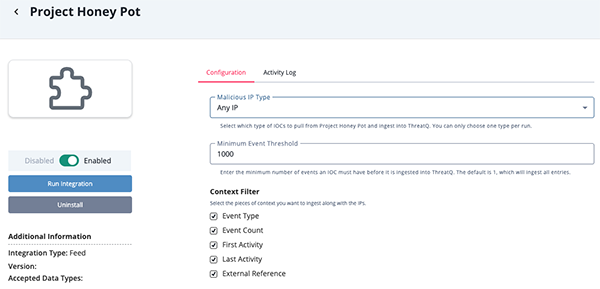Project Honey Pot CDF
The web format of this guide reflects the most current release. Guides for older iterations are available in PDF format.
Integration Details
ThreatQuotient provides the following details for this integration:
| Current Integration Version | 1.0.1 |
| Compatible with ThreatQ Versions | >= 5.22.0 |
| Support Tier | ThreatQ Supported |
Introduction
The Project Honey Pot CDF enables analysts to automatically ingest IP Addresses related to spammers, harvesters, attackers, and more into ThreatQ.
Project Honey Pot is a distributed system for identifying spammers and the spambots they use to scrape addresses from your website. Project Honey Pot tracks IPs that are known to be used by spammers, harvesters, and other malicious actors. These IPs are then used to generate a blacklist that can be used to block malicious traffic.
The integration provides the following feed:
- Project Honey Pot - pulls IPs from the Project Honey Pot RSS feed based on the specified
ip_type.
The integration ingests IP Address type indicators.
Installation
Perform the following steps to install the integration:
The same steps can be used to upgrade the integration to a new version.
- Log into https://marketplace.threatq.com/.
- Locate and download the integration file.
- Navigate to the integrations management page on your ThreatQ instance.
- Click on the Add New Integration button.
- Upload the integration file using one of the following methods:
- Drag and drop the file into the dialog box
- Select Click to Browse to locate the integration file on your local machine
ThreatQ will inform you if the feed already exists on the platform and will require user confirmation before proceeding. ThreatQ will also inform you if the new version of the feed contains changes to the user configuration. The new user configurations will overwrite the existing ones for the feed and will require user confirmation before proceeding.
- The feed will be added to the integrations page. You will still need to configure and then enable the feed.
Configuration
ThreatQuotient does not issue API keys for third-party vendors. Contact the specific vendor to obtain API keys and other integration-related credentials.
To configure the integration:
- Navigate to your integrations management page in ThreatQ.
- Select the OSINT option from the Category dropdown (optional).
If you are installing the integration for the first time, it will be located under the Disabled tab.
- Click on the integration entry to open its details page.
- Enter the following parameters under the Configuration tab:
Parameter Description Malicious IP Type Select which type of IOCs to pull from Project Honey Pot and ingest into ThreatQ. Options include: - All IPs (default)
- Harvesters
- Spam Servers
- Bad Web Hosts
- Comment Spammers
- Dictionary Attackers
- Rule Breakers
- Search Engines
You can only choose one type per run.
Minimum Event Threshold Enter the minimum number of events an IOC must have before it is ingested into ThreatQ. The default is 1, which will ingest all entries. Context Filter Select the pieces of context you want to ingest along with the IPs. Options include: - Event Type (default)
- Event Count
- First Activity
- Last Activity
- External Reference

- Review any additional settings, make any changes if needed, and click on Save.
- Click on the toggle switch, located above the Additional Information section, to enable it.
ThreatQ Mapping
Project Honey Pot
The Project Honey Pot feed periodically pulls IPs from the Project Honey Pot RSS feed based on the specified ip_type.
GET https://www.projecthoneypot.org/list_of_ips.php?rss=1&t={{ip_type}}
Sample Response:
<rss version="2.0">
<channel>
<title>Search Engine IPs | By Last Crawl | Project Honey Pot</title>
<link><![CDATA[ http://www.projecthoneypot.org/list_of_ips.php&t=se ]]></link>
<description />
<copyright>Copyright 2023 Unspam Technologies, Inc</copyright>
<language>en-us</language>
<lastBuildDate>July 16 2023 10:00:21 PM</lastBuildDate>
<image>
<url>http://www.projecthoneypot.org/images/small_phpot_logo.jpg</url>
<title>Project Honey Pot | Distribute Spammer Tracking System</title>
<link>http://www.projecthoneypot.org</link>
</image>
<item>
<title>66.249.66.6 | Se</title>
<link>http://www.projecthoneypot.org/ip_66.249.66.6</link>
<description>Event: Crawl | Total: 2,207 | First: 2017-01-07 | Last: 2023-07-16</description>
<pubDate>July 16 2023 10:00:21 PM</pubDate>
</item>
</channel>
</rss>ThreatQuotient provides the following default mapping for this feed:
| Feed Data Path | ThreatQ Entity | ThreatQ Object Type or Attribute Key | Published Date | Examples | Notes |
|---|---|---|---|---|---|
.title |
Indicator.Value | IP Address | .pubDate |
66.249.66.6 |
N/A |
.link |
Indicator.Attribute | External Reference | .pubDate |
http://www.projecthon |
N/A |
.description |
Indicator.Attribute | Event Type | .pubDate |
Crawl |
First section of field |
.description |
Indicator.Attribute | Event Count | .pubDate |
2207 |
Second section of field. Updates at ingestion time. |
.description |
Indicator.Attribute | First Activity | .pubDate |
2017-01-07 |
Third section of field |
.description |
Indicator.Attribute | Last Activity | .pubDate |
2023-07-16 |
Fourth section of field. Updates at ingestion time. |
Average Feed Run
Object counts and Feed runtime are supplied as generalities only - objects returned by a provider can differ based on credential configurations and Feed runtime may vary based on system resources and load.
| Metric | Result |
|---|---|
| Run Time | 1 minute |
| Indicators | 32 |
| Indicator Attributes | 160 |
Known Issues / Limitations
- The Project Honey Pot feed only pulls back a maximum of 50 results per run.
- Country Codes will not be available through this feed.
Change Log
- Version 1.0.1
- The URL now uses SSL to avoid HTTP redirects.
- Version 1.0.0
- Initial release
PDF Guides
| Document | ThreatQ Version |
|---|---|
| Project Honey Pot CDF Guide v1.0.1 | 5.22.0 or Greater |
| Project Honey Pot CDF Guide v1.0.0 | 5.22.0 or Greater |